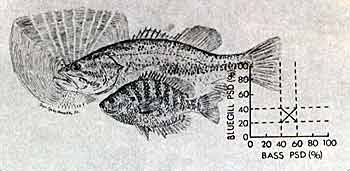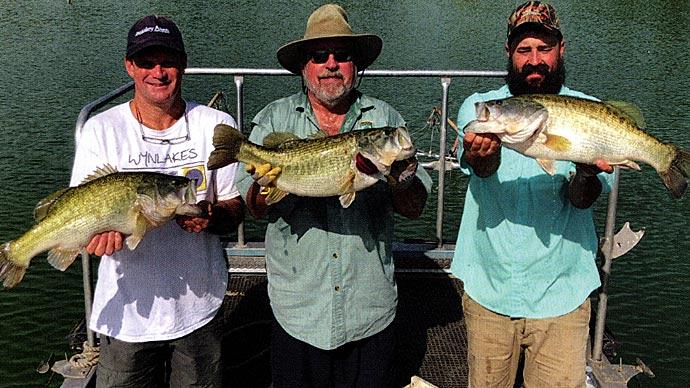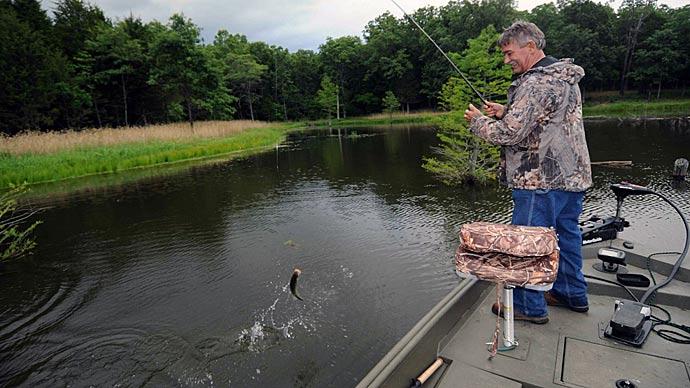
Management by objectives is an important way of life for pond owners as well as CEO's and custodians. For pond owners I would propose a goal of sustained good quality fishing.
That goal is achieved starting with water quality. Water with its associated dissolved and suspended materials determines pond productivity or capacity to produce and sustain pounds of fish. All ponds have a carrying capacity. Most ponds range from 100 to 400 pounds per acre. In good fishing ponds largemouth bass account for 20 to 40 % of total fish weight.
Pond carrying capacity is also determined by habitat. Habitat influences food chains and a fish's ability to reproduce, survive, and grow.
The goal of sustained good fishing depends on an appropriate association of fish species. My favorite is the combination of largemouth bass and bluegill. Once a pond'has been properly built, if water quality and productivity are good, with proper stocking and satisfactory survival and growth, each population will exhibit measurable attributes.
Pounds per acre and biomass ratios identified by Dr. Homer S. Swingle, famous researcher from Auburn University, are relevant but difficult to estimate unless ponds can be drained.

An index of population structure that reflects rates of reproduction, growth, and survival is based on length-frequency distribution. The statistic is proportional size distribution (PSD). For fish of preferred size the index is PSD-P. If 10 bluegills are caught and 4 have lengths less than 6 inches, the angling PSD is 60. If 2 are longer than 8 inches, the standard for preferred size of bluegill, the PSD-P is 20.
For you serious pondmeisters, use these equations to project what to expect from your pond as nature provides. For dedicated pond managers, in an ideal world, anglers should maintain records of size groups of every largemouth bass and bluegill caught on all trips. Important size groups for bluegill are less than 6 inches, 6-8 inches, and 8 inches and longer. For largemouth bass, the size groups are 8-12, 12-15, and preferred size is 15 inches and longer. Angler PSD of largemouth bass is often a good estimate of population PSD. A balanced population of largemouth bass has a PSD of 20-60. In a good population, the proportion caught by angling 8-12 inches will be 40-80. Those over 15 inches may be 5 to 25%.
Sound complicated? It's not. Bass and bluegill populations are dynamic, changing all the time. Fish spawn, some are eaten, and some fast growing, aggressive, elusive fish are recruited into the system. Since the population tends to be dynamic, these calculations are even more important as they give you direction as to when to harvest fish in order to maintain objective size distributions. For people who want the pond to do the work naturally, this is how you figure out your role as an angler to keep largemouth PSD where it should be via proper harvest. Be careful not to overharvest your fish or the natural ebb and flow will push your fishery to excess, which you aren't likely to enjoy.

However, angler PSD of bluegill usually does not reflect population PSD because few adult fish as small as 3 inches are caught. How many small bluegills do you actually catch? This fact skews this analysis. Angler PSD for a well-structured bluegill population is 50-80. Females are in good condition, spawn repeatedly, and produce an abundance of young every year. Predation by largemouth bass crops the surplus of 1-4 inch bluegills so that population density is reduced and satisfactory growth and condition of bluegill are sustained. Largemouth bass longer than 12 inches are important to sustain that bluegill mortality to keep bluegill PSD in its proper frame.
Balanced fish communities can be sustained by proper and appropriate harvest if or when there is a surplus. However, a bluegill PSD of 50-80 and largemouth PSD of 20-60 reflect the Balance of Nature. Given this community structure, the total weight of bluegill is about 50% of carrying capacity for bluegill; largemouth bass are at 100% of their carrying capacity because they consume the maximum sustained yield of prey.
This divine structure can be seen in virgin populations and can stimulate angler dreams and expensive vacations.
Such structure can be sustained by catch and release of both largemouth bass and bluegills. Harvest of adult bluegills could reduce reproduction and recruitment of prey for largemouth bass. Harvest of largemouth bass of quality and preferred size could permit high survival of young bluegill and competition for food and/or predation on young largemouth bass. Low recruitment of largemouth bass and unbalanced fish communities could be the sustained end result. Bluegill population could expand to nearly 100% of carrying capacity and near 0 PSD.
Managing a pond naturally is about allowing your pond to do what it can do, learning its capabilities by the fish it produces, tracking its progress by monitoring PSD with angling records, and then adjusting the fishery to keep its desired structure with catch and release or selective harvest. This is the blueprint of choice for good fishing and fond memories in a naturally managed pond.
Reprinted with permission from Pond Boss Magazine



